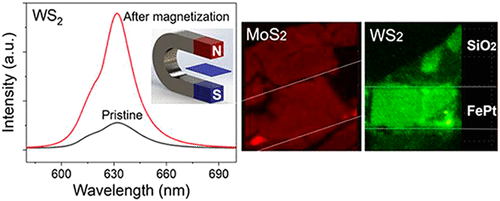当前位置:
X-MOL 学术
›
ACS Photonics
›
论文详情
Our official English website, www.x-mol.net, welcomes your
feedback! (Note: you will need to create a separate account there.)
Improved Photoluminescence in 2D Semiconductors Induced by Interface Magnetization
ACS Photonics ( IF 6.5 ) Pub Date : 2020-11-18 , DOI: 10.1021/acsphotonics.0c01575 Nengjie Huo 1 , Le Huang 2 , Kaixiang Shu 1 , Mengmeng Yang 2 , Dongxiang Luo 1 , Jingbo Li 1
ACS Photonics ( IF 6.5 ) Pub Date : 2020-11-18 , DOI: 10.1021/acsphotonics.0c01575 Nengjie Huo 1 , Le Huang 2 , Kaixiang Shu 1 , Mengmeng Yang 2 , Dongxiang Luo 1 , Jingbo Li 1
Affiliation

|
Background charges or defects can substantially lower the photoluminescence (PL) in two-dimensional (2D) transition-metal dichalcogenides (TMDCs). Previous technologies such as chemical passivation or electrostatic doping for the PL enhancement have suffered from either contamination or complex structures. Here we proposed a new strategy to modulate the optical properties of TMDCs utilizing the ferromagnetic film. The interface magnetization can lead to the significantly enhanced PL intensity of monolayer WS2, while it has a negligible effect on MoS2. First principle calculations reveal that the spin-polarized holes can inject into WS2 more efficiently from the ferromagnetic FePt film due to the significant orbital overlap, giving rise to the conversion of trions to excitons facilitating the radiative recombination. This is the first report on the modulation of PL in TMDCs by interface magnetization and can open the door for the development of highly efficient optoelectronics and spintronics based on 2D semiconductors.
中文翻译:

界面磁化在二维半导体中改善了光致发光
背景电荷或缺陷会大大降低二维(2D)过渡金属二卤化金属(TMDC)中的光致发光(PL)。用于PL增强的化学钝化或静电掺杂等先前技术已遭受污染或结构复杂的困扰。在这里,我们提出了一种利用铁磁膜调制TMDCs光学特性的新策略。界面磁化可导致单层WS 2的PL强度显着提高,而对MoS 2的影响可忽略不计。第一性原理计算表明,自旋极化的空穴可以注入WS 2中由于明显的轨道重叠,铁磁性FePt薄膜的效率更高,从而导致三重子向激子的转化,从而促进了辐射复合。这是有关通过界面磁化对TMDC中的PL进行调制的第一份报告,它可以为基于2D半导体的高效光电和自旋电子学的发展打开大门。
更新日期:2020-12-16
中文翻译:

界面磁化在二维半导体中改善了光致发光
背景电荷或缺陷会大大降低二维(2D)过渡金属二卤化金属(TMDC)中的光致发光(PL)。用于PL增强的化学钝化或静电掺杂等先前技术已遭受污染或结构复杂的困扰。在这里,我们提出了一种利用铁磁膜调制TMDCs光学特性的新策略。界面磁化可导致单层WS 2的PL强度显着提高,而对MoS 2的影响可忽略不计。第一性原理计算表明,自旋极化的空穴可以注入WS 2中由于明显的轨道重叠,铁磁性FePt薄膜的效率更高,从而导致三重子向激子的转化,从而促进了辐射复合。这是有关通过界面磁化对TMDC中的PL进行调制的第一份报告,它可以为基于2D半导体的高效光电和自旋电子学的发展打开大门。











































 京公网安备 11010802027423号
京公网安备 11010802027423号